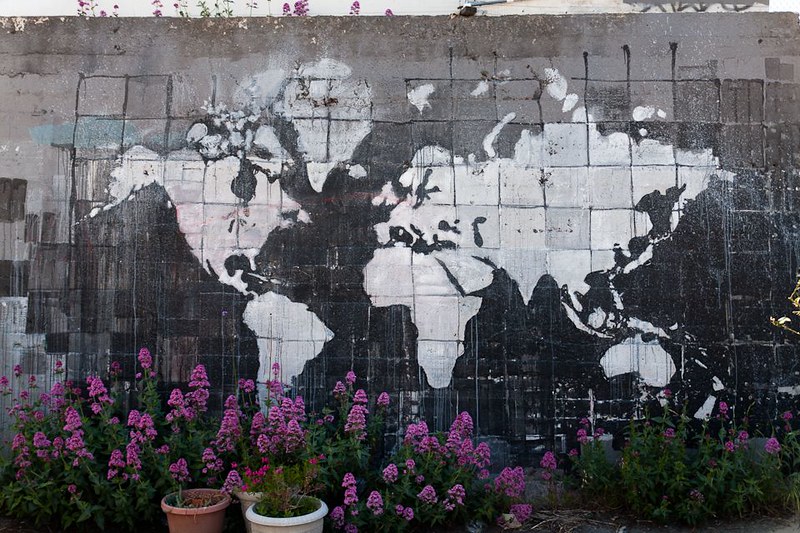There are 3 major locations in Children of the Night.
- Eastern Europe, in the vicinity of the Porumbar Kalnas (Blackthorne Castle). This is the home of Count Grimlocke.
- The outskirts of London, in the environs of Applewood Estate. This is 1960’s period London, mind you.
- The beachside town of Ocracoke, North Carolina, at Scuppernong Manor. Ocracoke is also the name of the island where the town sits. It is in the Outer Banks & part of the Cape Hatteras National Seashore.

Why Eastern Europe?
In many vampire tales, Eastern Europe is often used as shorthand for “the edge of civilization”. Romania, Czechoslovakia, Lithuania and other neighboring countries have long been battlegrounds between Western and Eastern cultures. They were fought over by various Christian, Mongolian, and Ottoman empires. Even today, they are the site of proxy wars between Democratic states and Autocracies. Constant strife created many small, distinct and culturally isolated principalities, dukedoms, and other exotic states. In these insular territories, almost any insanity could occur without being noticed by the outside world.
We chose to be deliberately vague about the location of Count Grimlocke’s home. It would be reasonable to assume that the territory around his Kalnas was wrested from the locals during the Baltic Crusades. Or, Grimolocke could make his home in one of the areas that supplied troops to that mostly-forgotten military campaign. Perhaps “east of Riga” would be a fair starting point for finding this shadowy fictional realm.

A dark & forbidding fruity fortification
Castles of the late 13th century were undergoing design changes. They had been crude, brutal fortresses. But, they were getting fancy. This era marked the last stand of motte and bailey castle design. The Renaissance was starting to make its mark.
In previous generations, nobles would build “a mound of earth as high as they can and dig a ditch about it as wide and deep as possible. The space on top of the mound is enclosed by a palisade of very strong hewn logs, strengthened at intervals by as many towers as their means can provide. Inside the enclosure is a citadel, or keep, which commands the whole circuit of the defences. The entrance to the fortress is by means of a bridge, which, rising from the outer side of the moat and supported on posts as it ascends, reaches to the top of the mound.”
This is the description given byJean de Colmieu around 1130. He was describing matte & bailey castles in the Calais region.
As siege weaponry became more sophisticated (trebuchets, catapults, and even early cannons), castles began to incorporate more stonework. Towers allowed defenders to use the advantages of height to counter the attackers advantages of mobility. Concentric design, with layers of curtain walls providing defenses in depth around a fortified keep eventually became the most widespread castle design in the Middle Ages. Porumbar Kalnas would likely be a transitional castle, with elements of heavy, brutal earthworks, supplanted with elegant stone walls and accrued additional features.

Porumbar, by the way, is Romanian for “Blackthorn trees” (Prunus spinosa). Blackthorne bushes are widespread in Eastern Europe. They produce a blue-to-black fruit similar in shape and size to a blueberry. The collective name for Blackthorn fruit is “sloes” (or Slånbär). Sloes are primarily used in making Sloe Gin. We do stay true to our roots as writers who drink, don’t we?
Blackthorn wood was long associated with witches wands and shillelaghs. It is dense and strong. And, ironically enough, Porumbar trees grow best in full sunlight.

London in the Swinging 60’s
London had it going on. In Dracula, the titular vampire seeks to relocate to a richer, more populous hunting ground in the capitol of the United Kingdom. Following his lead, our family of Vampires makes tracks for London.
Not only is Londontown a traditional Gothic change-of-pace from the Old World, but in the 1960’s it was *the* place to be. The staging ground for the British Invasion of global culture and high-tide mark for the British Empire was also a melting pot for cultures from around the world. It was a busy place where lots of transients went missing without being missed.
1960’s London was a crossroads, which makes it a perfect setting for the middle of our 3-act play. In-between two isolated and lonely settings, we chose it for a lively change of pace. London was a glitzy but violent place, with musicians and other Bohemian artists rubbing elbows with crass mobsters.

Our clan of Vampires settles at the fictional Applewood Estate. This is keeping with our motif of wood & booze. This suburban estate is a thinly veiled reference to Appleton Estate, a particularly tasty Jamaican rum. Appleton Estate (especially the VS) is a rum with terroir. Decades ago, George once visited Jamaica & has kept Appleton Estate stocked in his drinking cabinet ever since. Did I mention that we drink as we write?

The Outer Banks
The final setting of Children of the Night was inspired by a few different factors. First, we wanted somewhere isolated and quirky, yet also on the “I’ve heard of there” list for most audiences. Second, George is familiar with the Outer banks – having been stationed on Ocracoke for 3-months working as a Park Ranger during OBX hurricane season.
Another major reason for the third act setting is our greed. There was a playwriting contest with a $1,000 purse which challenged authors to incorporate elements of Southern culture that had not otherwise appeared on stage. The Outer Banks Brogue has, to the best of our knowledge, never appeared on stage. So, documenting and popularizing this unique and archaic accent worked as an academic figleaf. And, we thought it would be amusing to slip a vampire play (one *not* set in New Orleans) into the mix and see if the reviewers would… bite.
The final great house of the play is Scuppernong Manor. It’s an pastiche of various Sea Captain’s homes. Scuppernong Manor is built along the shores of Silver Lake in Ocracoke Village. It’s name also pays tribute to another libation. Scuppernong is a rare native North American grape which is naturally resistant to the scourge of Phylloxera. It produces a wine that is, believe it or not, bright green in the bottle!

The Outer Banks are also known as the Graveyard of the Atlantic. More than 2,000 vessels were shipwrecked along the shores of the OBX. The Outer Banks separate the Atlantic Ocean from Currituck and Albemarle Sounds (to the north) and Pamlico Sound (south). Many of the islands are uninhabited, and the few that have communities are very isolated. They are far enough from the mainland that they acted as bastions of language and culture. Nowadays, many of the old family homes are being converted into Bed and Breakfasts or being bought out by wealthy outlanders as summer homes.
Inhabited islands and Cities along the Outer Banks include (from North to South):
–1) Currituck Banks: Sandbridge / Carova Beach / Corolla / Knotts Island
–2) Bodie Island: Duck / Southern Shores / Kitty Hawk / Kill Devil Hills / Nags Head
–3) Roanoke Island: Manteo / Wanchese
–4) Hatteras Island: Rodanthe / Waves / Salvo / Avon / Buxton / Frisco / Hatteras
–5) Ocracoke Island: Ocracoke Village
–6) Core Banks: Portsmouth Island
–7) Bogue Banks: Atlantic Beach / Pine Knoll Shores / Indian Beach / Salter Path / Emerald Isle

